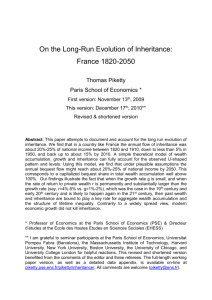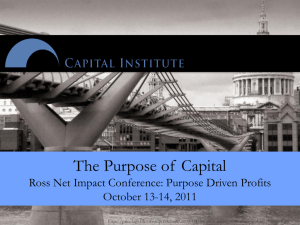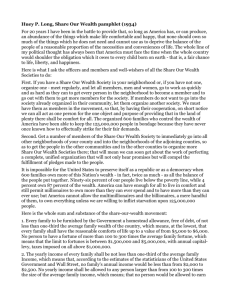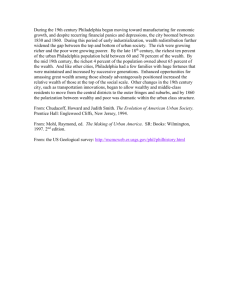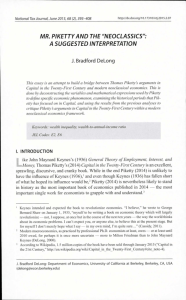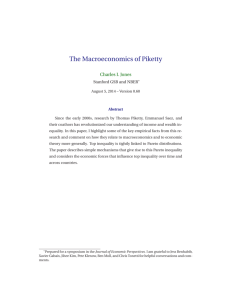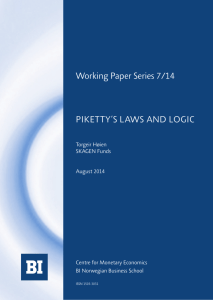Free exchange: All men are created unequal | The Economist
advertisement
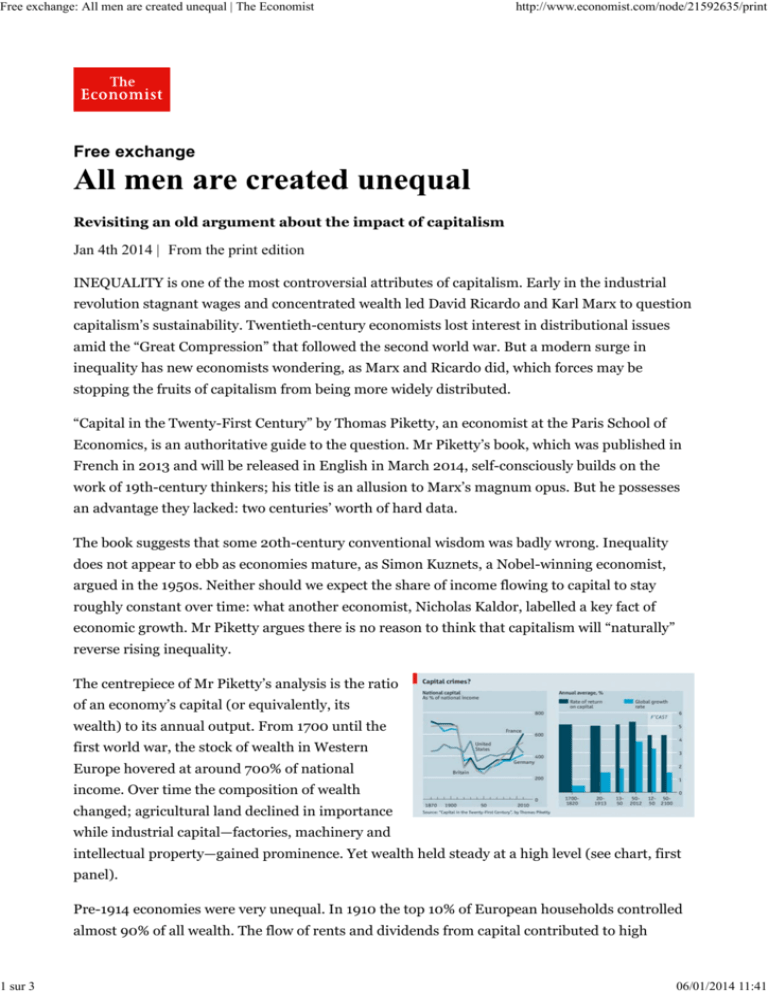
Free exchange: All men are created unequal | The Economist 1 sur 3 http://www.economist.com/node/21592635/print Free exchange Revisiting an old argument about the impact of capitalism Jan 4th 2014 | From the print edition INEQUALITY is one of the most controversial attributes of capitalism. Early in the industrial revolution stagnant wages and concentrated wealth led David Ricardo and Karl Marx to question capitalism’s sustainability. Twentieth-century economists lost interest in distributional issues amid the “Great Compression” that followed the second world war. But a modern surge in inequality has new economists wondering, as Marx and Ricardo did, which forces may be stopping the fruits of capitalism from being more widely distributed. “Capital in the Twenty-First Century” by Thomas Piketty, an economist at the Paris School of Economics, is an authoritative guide to the question. Mr Piketty’s book, which was published in French in 2013 and will be released in English in March 2014, self-consciously builds on the work of 19th-century thinkers; his title is an allusion to Marx’s magnum opus. But he possesses an advantage they lacked: two centuries’ worth of hard data. The book suggests that some 20th-century conventional wisdom was badly wrong. Inequality does not appear to ebb as economies mature, as Simon Kuznets, a Nobel-winning economist, argued in the 1950s. Neither should we expect the share of income flowing to capital to stay roughly constant over time: what another economist, Nicholas Kaldor, labelled a key fact of economic growth. Mr Piketty argues there is no reason to think that capitalism will “naturally” reverse rising inequality. The centrepiece of Mr Piketty’s analysis is the ratio of an economy’s capital (or equivalently, its wealth) to its annual output. From 1700 until the first world war, the stock of wealth in Western Europe hovered at around 700% of national income. Over time the composition of wealth changed; agricultural land declined in importance while industrial capital—factories, machinery and intellectual property—gained prominence. Yet wealth held steady at a high level (see chart, first panel). Pre-1914 economies were very unequal. In 1910 the top 10% of European households controlled almost 90% of all wealth. The flow of rents and dividends from capital contributed to high 06/01/2014 11:41 Free exchange: All men are created unequal | The Economist 2 sur 3 http://www.economist.com/node/21592635/print inequality of income; the top 10% captured more than 45% of all income. Mr Piketty’s work suggests there was little sign of any natural decline in inequality on the outbreak of the first world war. The wars and depressions between 1914 and 1950 dragged the wealthy back to earth. Wars brought physical destruction of capital, nationalisation, taxation and inflation, while the Great Depression destroyed fortunes through capital losses and bankruptcy. Yet capital has been rebuilt, and the owners of capital have prospered once more. From the 1970s the ratio of wealth to income has grown along with income inequality, and levels of wealth concentration are approaching those of the pre-war era. Mr Piketty describes these trends through what he calls two “fundamental laws of capitalism”. The first explains variations in capital’s share of income (as opposed to the share going to wages). It is a simple accounting identity: at all times, capital’s share is equal to the rate of return on capital multiplied by the total stock of wealth as a share of GDP. The rate of return is the sum of all income flowing to capital—rents, dividends and profits—as a percentage of the value of all capital. The second law is more a rough rule of thumb: over long periods and under the right circumstances the stock of capital, as a percentage of national income, should approach the ratio of the national-savings rate to the economic growth rate. With a savings rate of 8% (roughly that of the American economy) and GDP growth of 2%, wealth should rise to 400% of annual output, for example, while a drop in long-run growth to 1% would push up expected wealth to 800% of GDP. Whether this is a “law” or not, the important point is that a lower growth rate is conducive to higher concentrations of wealth. In Mr Piketty’s narrative, rapid growth—from large productivity gains or a growing population—is a force for economic convergence. Prior wealth casts less of an economic and political shadow over the new income generated each year. And population growth is a critical component of economic growth, accounting for about half of average global GDP growth between 1700 and 2012. America’s breakneck population and GDP growth in the 19th century eroded the power of old fortunes while throwing up a steady supply of new ones. Victorian values Tumbling rates of population growth are pushing wealth concentrations back toward Victorian levels, in Mr Piketty’s estimation. The ratio of wealth to income is highest among demographically challenged economies such as Italy and Japan (although both countries have managed to mitigate inequality through redistributive taxes and transfers). Interestingly, Mr Piketty reckons this world, in which the return to capital is persistently higher than growth, is the more “normal” state. In that case, wealth piles up faster than growth in output or incomes. The mid-20th century, when wealth compression combined with extraordinary growth to generate an egalitarian interregnum, was the exception. Sustained rates of return above the rate of growth may sound unrealistic. The more capital there 06/01/2014 11:41 Free exchange: All men are created unequal | The Economist 3 sur 3 http://www.economist.com/node/21592635/print is, the lower the return should be: the millionth industrial robot adds less to production than the hundredth. Yet somewhat surprisingly, the rate of return on capital is remarkably constant over long periods (see chart, second panel). Technology is partly responsible. Innovation, and growth in output per person, creates investment opportunities even when shrinking populations reduce GDP growth to near zero. New technology can also make it easier to substitute machines for human workers. That allows capital to gobble up a larger share of national income, raising its return. Amid a new burst of automation, wealth concentrations and inequality could reach unprecedented heights, putting a modern twist on a very 19th- century problem. Economist.com/blogs/freeexchange (http://www.economist.com/blogs/freeexchange) From the print edition: Finance and economics 06/01/2014 11:41




